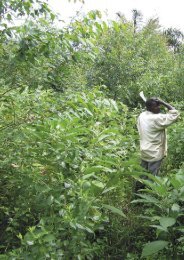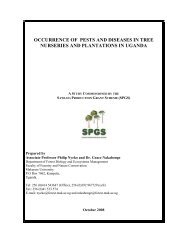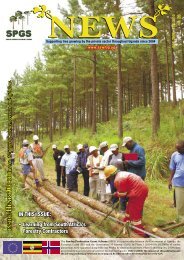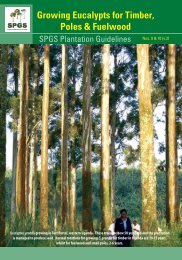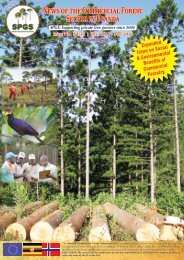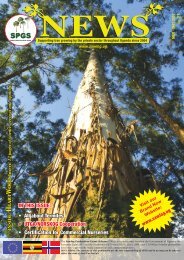download - SPGS
download - SPGS
download - SPGS
Create successful ePaper yourself
Turn your PDF publications into a flip-book with our unique Google optimized e-Paper software.
SAWLOG PRODUCTION GRANT SCHEME - MAY - JULY 2009. ISSUE NO. 24<br />
From p. 7<br />
HEADING SOUTH...<br />
for fine details of a suspected fire or suspicious activity and<br />
alert nearby ground crew to take remedial action.<br />
The fire surveillance company provides a 24 hour surveillance<br />
service to many private forest plantation owners in the<br />
250km radius at an agreed fee. The impressive thing about<br />
this arrangement is that forest owners need not invest in<br />
expensive fire surveillance equipment of their own. All<br />
they need to have in place are good fire fighting crews<br />
and equipment. Another aspect of this organization that<br />
impressed us is the public awareness programme under the<br />
“Mlilo kills” slogan. The programme targets both grownups<br />
and school children. The immediate benefits are attitude<br />
change of grown-ups towards fire danger since the message<br />
is continuously being put across. The long-term impact is<br />
on young children who grow up with a positive attitude<br />
towards the dangers of fire.<br />
All South African and Swazi<br />
plantation forest companies have<br />
fire fighting equipment ranging<br />
from small units that are normally<br />
mounted at the back of pick-up<br />
trucks. These can be handy in<br />
putting out small fires or initiating<br />
a fire fighting operation while<br />
waiting for the arrival bigger<br />
equipment. Some companies have<br />
big fire trucks and even helicopters<br />
for fighting big fires that are<br />
common in that part of the world. All companies or their<br />
fire fighting contractors have well trained fire-fighting crews<br />
that are at different degrees of readiness depending on the<br />
fire index of the area.<br />
Although fire is generally destructive to forest plantations,<br />
the managers in the two countries visited at times use fire as<br />
a management tool. Burning under canopy or ‘cool burning’<br />
as it is referred to, reduces incidences of future fires by<br />
reducing dry brush from the floor of the forests.<br />
Forest road networks are very critical in fire management.<br />
They should therefore be well planned and properly<br />
maintained at all times. This enables fast movement of<br />
fire fighting crews and equipment. Both South African and<br />
Swazi timber growers maintain their forest road networks<br />
better than some of our so-called all weather. marrum trunk<br />
roads!<br />
Wide fire lines separating different compartments or blocks<br />
and clear of dry vegetation minimize the spread of fire and<br />
help in containing any fire outbreak in manageable units.<br />
Fire management involves more than just fire fighting or<br />
surveillance. A good communication strategy and programme<br />
can help minimize fire occurrences: we saw many signs and<br />
bill-boards carrying messages on the dangers caused by<br />
fires.<br />
One other strategy in fire management is maintenance of<br />
good public relations with local communities.<br />
South Africa has state of the art fire<br />
fighting systems. However, despite all the<br />
sophistication, the country suffered heavy<br />
losses of its forest plantations estimated<br />
at 130,000 hectares and millions of Rand<br />
during 2007 and 2008. This shows how<br />
serious fire can be and the loss it can<br />
cause to investments in forest plantations.<br />
Where possible employ your labour force from the<br />
local communities, pay competitive remunerations<br />
and provide additional welfare packages e.g.<br />
health insurance, food, transport (if work place is<br />
far from place of abode). Such seemingly simple<br />
things can ensure protection of ones investments by having<br />
a neighbouring community that identifies itself with such<br />
investments.<br />
Although our industrial plantation industry is still at<br />
infancy stage, all industrial tree growers should from the<br />
outset, incorporate fire management in their management<br />
plans and start investing in things like look-out points and<br />
communication equipment like walkie-talkies - especially<br />
those undertaking large scale planting. Fire is likely to be<br />
the biggest enemy of forest plantations with the prolonging<br />
dry seasons that are attributed to global warming.<br />
And finally, Mike Nsereko and Keeya Hood – Lessons<br />
Learned.<br />
Many of us who were on the recent trip to South Africa<br />
and Swaziland had never travelled for over 100km through<br />
planted forest. Between 8- 18/March/2009 it did happen.<br />
“We have only planted dots back<br />
home” commented Boaz Tishekwa,<br />
one of the guys we went with. “If<br />
we maintain the current momentum<br />
we shall also reach there with time”<br />
was the response of Paul Jacovelli<br />
who was leading our group.<br />
South Africa and Swaziland are<br />
home to millions of hectares of<br />
planted forest which are well<br />
managed. Most of the forests are<br />
planted with pine, gum and black<br />
wattle. In South Africa, the key players are Sappi and Mondi.<br />
The medium scale operators are also doing well with their<br />
own processing plants which are mechanized. The small<br />
operators also exist and a few of them use their crop to<br />
produce value added products like sawn timber. However<br />
the majority in this category sell to large scale companies.<br />
In Swaziland, in a Company called Montigny Investments<br />
owned by Mr. Neil Rijkenberg (a very enterprising investor),<br />
a lot of value addition takes place leading to the production<br />
and supply of a wide range of products including timber<br />
used on railways, mining timber, fencing poles, charcoal<br />
briquettes, ceiling boards, floor-boards and other products<br />
that are exported to South Africa and beyond. Neil explained<br />
to us that it is extremely important for any investor in the<br />
forestry sector to be mindful of the idea of value addition so<br />
as to be able to earn more money from his investment.<br />
Overall, the trip to South Africa and Swaziland was very<br />
educative and an eye opener for us. It showed us that what<br />
we have started in Uganda has potential for success if we<br />
do things the right way. In effect it encouraged us to work<br />
even harder. In that regard, we wish to extend our sincere<br />
thanks to <strong>SPGS</strong> for having afforded us this opportunity.<br />
We also wish to encourage all tree growers who have not<br />
gone to South Africa to endeavour to make the visit if any<br />
opportunity arises because the exposure will most certainly<br />
leave you a better tree grower than you were before.<br />
NEWS OF UGANDA’S COMMERCIAL TREE PLANTING FUND FOR THE PRIVATE SECTOR<br />
13



